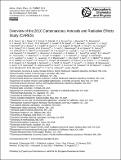Overview of the 2010 Carbonaceous Aerosols and Radiative Effects Study (CARES)
Author(s)
Cziczo, Daniel James
Downloaddan paper 2.pdf (22.32Mb)
PUBLISHER_CC
Publisher with Creative Commons License
Creative Commons Attribution
Terms of use
Metadata
Show full item recordAbstract
Substantial uncertainties still exist in the scientific understanding of the possible interactions between urban and natural (biogenic) emissions in the production and transformation of atmospheric aerosol and the resulting impact on climate change. The US Department of Energy (DOE) Atmospheric Radiation Measurement (ARM) program's Carbonaceous Aerosol and Radiative Effects Study (CARES) carried out in June 2010 in Central Valley, California, was a comprehensive effort designed to improve this understanding. The primary objective of the field study was to investigate the evolution of secondary organic and black carbon aerosols and their climate-related properties in the Sacramento urban plume as it was routinely transported into the forested Sierra Nevada foothills area. Urban aerosols and trace gases experienced significant physical and chemical transformations as they mixed with the reactive biogenic hydrocarbons emitted from the forest. Two heavily-instrumented ground sites – one within the Sacramento urban area and another about 40 km to the northeast in the foothills area – were set up to characterize the evolution of meteorological variables, trace gases, aerosol precursors, aerosol size, composition, and climate-related properties in freshly polluted and "aged" urban air. On selected days, the DOE G-1 aircraft was deployed to make similar measurements upwind and across the evolving Sacramento plume in the morning and again in the afternoon. The NASA B-200 aircraft, carrying remote sensing instruments, was also deployed to characterize the vertical and horizontal distribution of aerosols and aerosol optical properties within and around the plume. This overview provides: (a) the scientific background and motivation for the study, (b) the operational and logistical information pertinent to the execution of the study, (c) an overview of key observations and initial findings from the aircraft and ground-based sampling platforms, and (d) a roadmap of planned data analyses and focused modeling efforts that will facilitate the integration of new knowledge into improved representations of key aerosol processes and properties in climate models.
Date issued
2012-08Department
Massachusetts Institute of Technology. Department of Earth, Atmospheric, and Planetary SciencesJournal
Atmospheric Chemistry and Physics
Publisher
Copernicus GmbH
Citation
Zaveri, R. A. et al. “Overview of the 2010 Carbonaceous Aerosols and Radiative Effects Study (CARES).” Atmospheric Chemistry and Physics 12.16 (2012): 7647–7687.
Version: Final published version
ISSN
1680-7324
1680-7316